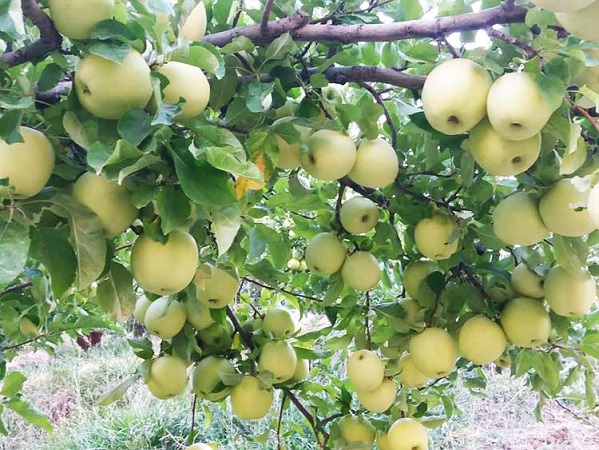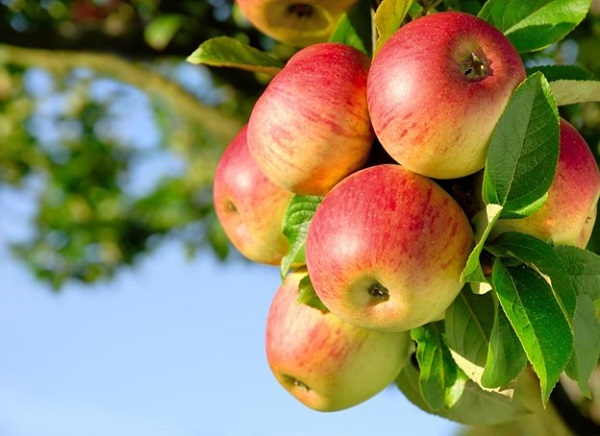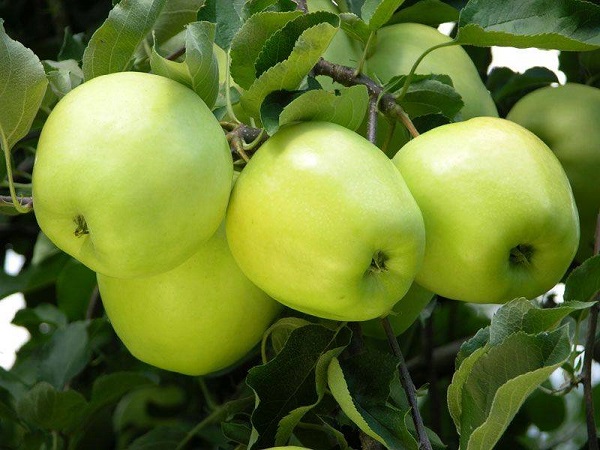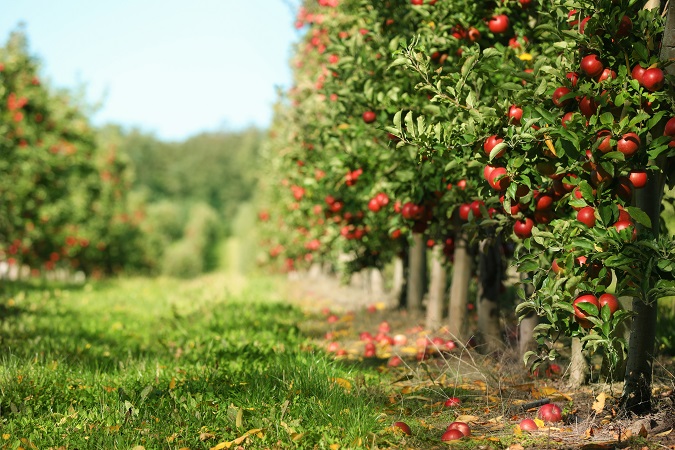
Comprehensive Nutrition and Fertilization Program for Apple Trees
Apple trees are among the most popular and high-yielding fruit trees worldwide. Proper nutrition is a key factor in enhancing the quality and quantity of apple production. To harvest premium-quality fruit, orchardists must meet the tree’s needs through optimal irrigation and a well-planned fertilization program for apple trees.
The fertilization plan for apple trees varies depending on the tree’s age, climate, soil type, and the soil’s nutritional requirements. In this article, we’ll outline the essential fertilizers for apple trees and provide a detailed, science-based fertilization program tailored to their needs.
The Importance of Apple Trees Fertilization
Apple trees require essential nutrients to support healthy growth and fruit production. These nutrients include primary elements like nitrogen, phosphorus, and potassium, as well as micronutrients such as iron, zinc, and manganese. Each plays a unique role in the tree’s metabolic processes.
While nutrients occur naturally in soil, they gradually deplete due to plant uptake, soil leaching, or environmental factors. Over time, this depletion leads to nutrient deficiencies, necessitating supplementation through fertilizers. Fertilization is critical for several reasons:
- Promoting root, stem, and leaf development
- Boosting fruit yield
- Enhancing resistance to diseases and pests
- Improving fruit quality (size, flavor, and nutritional value)
- Maintaining soil health and orchard ecosystem balance through a regular, science-based nutrition plan
- Ensuring long-term sustainability and productivity of the orchard

What Are the Nutritional Requirements of Apple Trees?
Meeting the nutritional needs of apple trees is critical for their health and productivity. These requirements include both macronutrients and micronutrients, each playing a specific role in the tree’s biochemical and metabolic processes. Below, we break down the most important nutrients for apple trees:
Macronutrients
Macronutrients are essential elements required in larger quantities for the growth and development of apple trees. They are divided into primary macronutrients (most used agricultural fertilizers) and secondary macronutrients:
- Primary Macronutrients:
- Nitrogen (N): Vital for leaf and shoot growth, enhancing chlorophyll production and photosynthesis.
- Phosphorus (P): Supports root system development and energy transfer processes.
- Potassium (K): Regulates water balance, strengthens disease resistance, improves fruit quality, and aids in sugar production and metabolic functions.
- Secondary Macronutrients:
- Calcium (Ca): Strengthens cell walls and improves fruit firmness.
- Sulfur (S): Essential for protein synthesis and enzyme activity.
- Magnesium (Mg): A core component of chlorophyll, crucial for photosynthesis.
Micronutrients
Micronutrients are required in smaller amounts but are equally critical for healthy growth and development. Key micronutrients for apple trees include:
- Iron (Fe): Supports chlorophyll synthesis and energy transfer.
- Zinc (Zn): Vital for plant hormone production and protein metabolism. A deficiency can stunt growth and reduce yields.
- Boron (B): Aids in cell division, pollination, and sugar transport.
- Copper (Cu): Enhances immune function and metabolic processes.
- Manganese (Mn): Activates enzymes involved in photosynthesis and respiration.
- Molybdenum (Mo): Critical for nitrogen fixation and enzyme systems.
- Nickel (Ni): Required for urea breakdown and seed development.
- Chlorine (Cl): Supports osmosis and ionic balance.
Why Balanced Nutrition Matters
Each nutrient, whether macro or micro, contributes uniquely to the tree’s vigor, productivity, and fruit quality. For example:
- Nitrogen deficiency leads to yellowing leaves and weak growth.
- Lack of phosphorus results in poor root development and delayed maturity.
- Potassium shortages reduce drought tolerance and fruit sweetness.
- Micronutrient imbalances (e.g., zinc or copper deficiency) can cause leaf discoloration, reduced flowering, and lower yields.
A balanced nutrient regimen ensures robust growth, high-quality fruit, and long-term orchard sustainability. Regular soil testing and targeted fertilization are key to addressing deficiencies and optimizing tree health.

The Importance of Soil Testing for Assessing Apple Tree Needs
Soil testing is a fundamental practice in agriculture and orchard management, playing a critical role in optimizing the health and productivity of apple trees. By analyzing soil samples, growers can identify the levels of primary nutrients (nitrogen, phosphorus, potassium) and micronutrients (iron, zinc, manganese, etc.), enabling them to pinpoint the precise nutritional requirements of their trees.
Key Benefits of Soil Testing
- Optimizes fertilizer efficiency by targeting only what the soil lacks.
- Reduces environmental impact by minimizing excess fertilizer runoff.
- Enhances fruit quality and yield through balanced nutrition.
- Supports long-term soil health by maintaining nutrient and pH balance.
By integrating soil testing into their management strategy, orchardists can make data-driven decisions, maximize productivity, and ensure their apple trees thrive season after season. Regular testing—ideally every 2–3 years—is a small investment with significant returns for both crop quality and orchard sustainability.

Best Times for Apple Trees Fertilization
Timely and appropriate fertilization significantly impacts the growth and productivity of apple trees. A well-planned fertilization schedule should align with the tree’s specific needs in each season. Below is a seasonal guide to optimizing apple tree nutrition:
Spring
Early spring, before bud break and blossoming, is ideal for applying nitrogen-rich fertilizers. This supports vigorous leaf and shoot growth, setting the stage for a healthy growing season. Micronutrients (e.g., zinc, boron) can also be added during this period to strengthen flowers and young fruit.
Summer
During the fruit development phase (mid- to late summer), prioritize phosphorus, potassium, and calcium. These nutrients enhance fruit size, quality, and resistance to disorders like bitter pit. Avoid excessive nitrogen, as it can divert energy away from fruit maturation.
Fall
Post-harvest is critical for replenishing soil health. Apply organic fertilizers (e.g., compost, manure) or a balanced NPK blend to restore nutrients and improve soil structure. This prepares the tree for winter dormancy and ensures robust root development for the next season.
Winter
While trees are dormant, focus on basal trench fertilization: use the Drill-Hole method and incorporate slow-release fertilizers or organic matter. This method enriches the root zone without stimulating untimely growth. In late winter (February/March), prepare the soil for spring by tilling and adding amendments based on soil test results.
Timing of Apple Trees Fertilization
| Season | Timing | Fertilizer Type | Amount (Per Mature Tree) | Notes |
|---|---|---|---|---|
| Spring | Early spring | Nitrogen (chemical fertilizer) | 1–2 kg | Promotes rapid leaf and bud growth. |
| Micronutrients (Iron, Zinc, Manganese) | Based on soil test results | Enhances flowering and prevents deficiencies. | ||
| Summer | Mid-summer | Potassium | 1–2 kg potassium | Improves fruit quality and growth. |
| Phosphorus | 0.5–1 kg phosphorus | Supports energy production and root activity. | ||
| Calcium | As needed | Prevents fruit cracking. | ||
| Iron | As needed | Enhances fruit coloration (apply 1 month before harvest). | ||
| Fall | Post-harvest | Organic fertilizer (compost, manure) | 2–3 kg | Enriches soil and prepares trees for winter. |
| Balanced NPK fertilizer | 1–2 kg (if required) | Replenishes essential nutrients in the soil. | ||
| Winter | Late December/early January | Compost mix (aged manure, nitrogen, sulfur) | Varies | Applied via basal trench fertilization to nourish roots during dormancy. |
By following this seasonal nutrition program, gardeners can help improve the quality and yield of apple trees and benefit from producing high-quality, healthy fruit.
General Fertilization Guidelines for Apple Trees
As emphasized earlier, fertilizer application rates should always be based on the tree’s specific needs and soil test results. Proper dosing is critical to maintaining tree health and avoiding nutrient imbalances. If you lack experience, consult an agricultural specialist or seasoned grower to determine precise annual fertilizer quantities. Below, we outline a standard fertilization plan for mature apple trees:
Nitrogen (N):
- Annual Requirement: 1–2 kg per mature tree (adjust based on tree age and soil conditions).
- Timing: Apply in early spring (start of the growing season) using crystalline ammonium sulfate. For additional nitrogen later in the season, use granulated ammonium sulfate.
Phosphorus (P):
- Annual Requirement: 0.5–1 kg per tree (varies with soil needs).
- Timing: Best applied in early spring during flowering to support root development and energy transfer.
Potassium (K):
- Annual Requirement: 1–2 kg per mature tree.
- Timing: Apply during the growing season, particularly during fruit formation, to enhance fruit quality and drought resistance.
Micronutrients:
- Annual Requirement: 200–500 grams per micronutrient (e.g., iron, zinc, manganese), depending on soil deficiencies.
- Timing: Apply during flowering and early fruit development to address specific deficiencies and boost metabolic processes.

Key Considerations for Apple Trees Fertilization
An effective nutrition plan for apple trees requires careful attention to the unique conditions of each orchard. Below are essential guidelines to optimize tree health and productivity:
1. Soil Assessment & Orchard-Specific Needs:
- Soil Testing: Conduct regular soil analyses to determine nutrient levels, pH, and soil structure. This data is critical for tailoring fertilization programs for apple tree.
- Deficiency Diagnosis: Use test results to identify nutrient shortages (e.g., nitrogen, iron) and adjust fertilizer types/quantities accordingly.
- Soil Type: Account for soil texture (clay, sand, loam), as it affects water retention and nutrient availability. Amendments like organic matter may be needed to improve soil structure.
2. Timing & Environmental Factors:
- Soil Moisture: Fertilizers dissolve faster in moist soil. Irrigate before application if the soil is dry.
- Temperature: Apply fertilizers during cooler periods (early morning or late afternoon) to minimize evaporation and nutrient loss.
- Rainfall: Avoid fertilizing before heavy rain to prevent runoff and leaching.
- Environmental Stress: Adjust fertilization during droughts, frost, or extreme heat to avoid stressing the trees.
3. Best Practices:
- Split Applications: Divide nitrogen doses into multiple applications during the growing season for better uptake.
- Organic Integration: Combine synthetic fertilizers with compost or manure to enhance soil health.
- pH Management: Maintain soil pH between 6.0–7.0 to maximize nutrient availability. Lime or sulfur can adjust pH if needed.
By prioritizing soil health, environmental conditions, and targeted nutrient delivery, growers can ensure vigorous growth, high yields, and long-term orchard sustainability. Regular monitoring and adaptability are key to success.